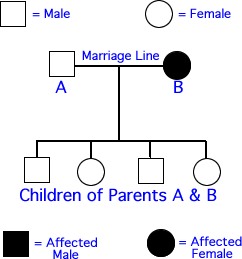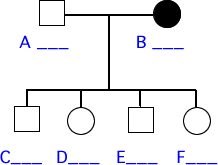
Pedigrees are charts that are used to study the inheritance of a trait within a family, or on a larger scale, within a closely related population. Pedigrees have been commonly used when dealing with breeds of animals (cats, dogs, horses, and cattle), but are also increasingly useful for zoos to prevent inbreeding within the zoo populations of a species scattered about the world. In humans, pedigrees are especially uselful in determining which members of a family may have a disease, and also in determining the odds that a couple will have a child with a birth defect.
Pedigrees are useful in showing the information known about individuals within a family, and with the collection of enough information, can help deduce the genotypes of each family member. As a standard, squares represents males and circles represent females. Squares and circles that are shaded in represent individuals affected by the studied condition. White or clear squares and circles represents unaffected individuals. Occasionally, you will find a chart with circles and squares that are filled with gray (or with a large central dot). These represent people who are unaffected by the condition but are still carriers of the allele (heterozygous). A straight horizontal line between a male and female represents a "marriage" or mating line. A vertical line descending from a marriage line represents the offspring of the parents.

------------------ ------------------
1.The pedigree below is studying the incidence of blonde hair in a family. In humans, dark hair (B) is dominant to blonde hair (b). In this case, individuals who are shaded in are homozygous recessive. Individuals who have clear circles and squares have at least one dominant gene.

What are the genotypes of persons A through F above?
[Answer]